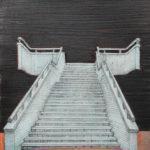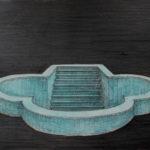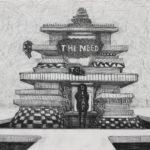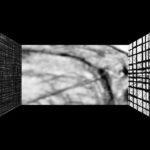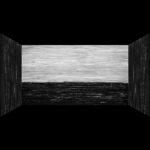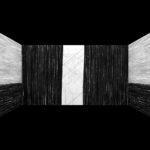Opening reception: Saturday, May 2 from 3-5pm
Robbie Cornelissen: The Black Room
Drawing Space: Robbie Cornelissen’s The Black Room
Text by Sasha Gora
There are three screens, to the left, right, and in front of us. In the centre of each a curtain is drawn, a sign that the show is about to begin. But this drawing of the curtain is literal. No heavy fabric is at work, only charcoal on paper, caught on camera and transformed into an animation. This is the opening scene of draughtsman Robbie Cornelissen’s 2014 video The Black Room. The screens may only be representations, but the atmosphere of the artwork makes it feel like we are standing in front of them.
The Black Room merges drawing and animation, sound and video to lift drawing off of the page. Lines and waves appear and disappear, pulsing between light and dark. Geometric shapes and grids scurry across the screen, morphing, occasionally, into figurative scenes and then back into abstractions. De Executikamer (Execution Room), a drawing from 2010, appears on the middle screen. A mattress and thin white sheets are strapped to a wooden support. The other screens zoom in and out, capturing the movement of the sheets, as if they were inhaling and exhaling.
In the execution room, there is a strong sense of the passing of time. Drawing lines, after all, is a way of keeping count. No one is to be seen, only the bed and the dark window above it. When was the room last used? When will it be used again? Who will be next? Because the human figure is absent, the viewer mentally occupies the space. Drawing, as well as Cornelissen’s practice, is about space – constructing, inhabiting, marking, defining and making sense of space. “Drawing is a form of probing,” writes John Berger in Bento’s Sketchbook: How Does the Impulse to Draw Something Begin?1
“And the first generic impulse to draw derives from the human need to search, to plot points, to place things and to place oneself.” Through Cornelissen’s use of two and three dimensions, drawing becomes sculptural. Take for example Little Boy Pissing at the Universe X that was part of his exhibition Studio Vertigo at the Centraal Museum, Utrecht in 2011. Created collaboratively with visitors, the line drawing measured 5.8 x 17 meters and transformed single lines drawn by visitors into a voluminous, sculptural artwork. Cornelissen’s work thus goes beyond representing space. Atmospheric, detailed and sometimes monumental in scale, his drawings, installations and videos create space for the viewer to wander through, inhabit and contemplate.
1 John Berger, Bento’s Sketchbook, (New York: Pantheon, 2011), 150.



